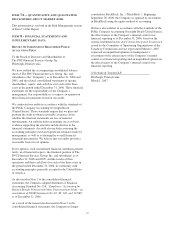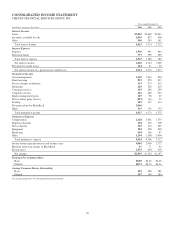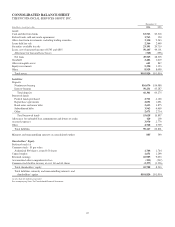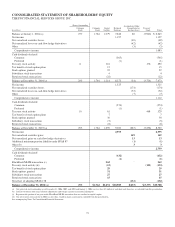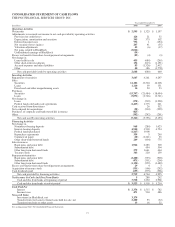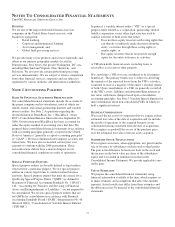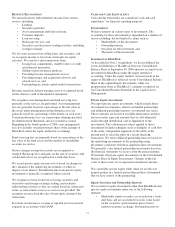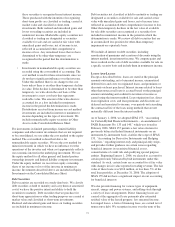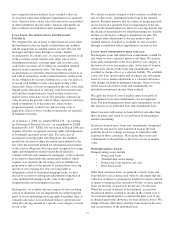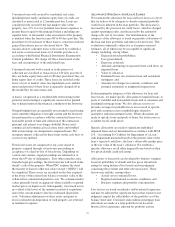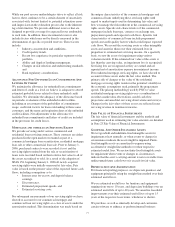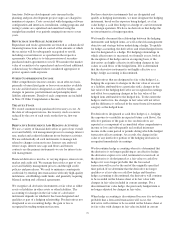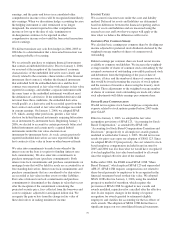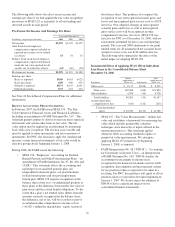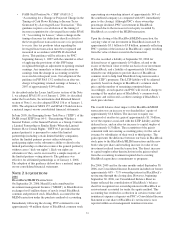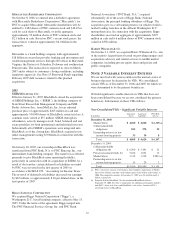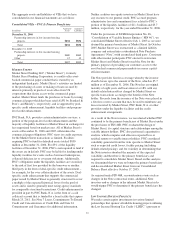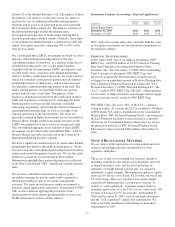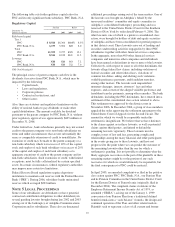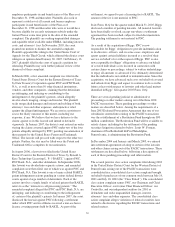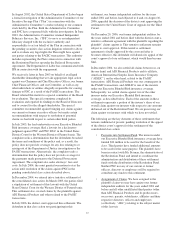PNC Bank 2006 Annual Report Download - page 87
Download and view the complete annual report
Please find page 87 of the 2006 PNC Bank annual report below. You can navigate through the pages in the report by either clicking on the pages listed below, or by using the keyword search tool below to find specific information within the annual report.While our pool reserve methodologies strive to reflect all risk
factors, there continues to be a certain element of uncertainty
associated with, but not limited to, potential estimation errors
and imprecision in the estimation process due to the inherent
lag of information. We provide additional reserves that are
designed to provide coverage for expected losses attributable
to such risks. In addition, these incremental reserves also
include factors which may not be directly measured in the
determination of specific or pooled reserves. These factors
include:
• Industry concentration and conditions,
• Credit quality trends,
• Recent loss experience in particular segments of the
portfolio,
• Ability and depth of lending management,
• Changes in risk selection and underwriting standards,
and
• Bank regulatory considerations.
A
LLOWANCE
F
OR
U
NFUNDED
L
OAN
C
OMMITMENTS
A
ND
L
ETTERS
O
F
C
REDIT
We maintain the allowance for unfunded loan commitments
and letters of credit at a level we believe is adequate to absorb
estimated probable losses related to these unfunded credit
facilities. We determine the adequacy of the allowance based
on periodic evaluations of the unfunded credit facilities
including an assessment of the probability of commitment
usage, credit risk factors for loans outstanding to these same
customers, and the terms and expiration dates of the unfunded
credit facilities. Net adjustments to the allowance for
unfunded loan commitments and letters of credit are included
in the provision for credit losses.
M
ORTGAGE AND OTHER LOAN
S
ERVICING
R
IGHTS
We provide servicing under various commercial and
residential loan servicing contracts. These contracts are either
purchased in the open market or retained as part of a
commercial mortgage loan securitization, residential mortgage
loan sale or other commercial loan sale. Prior to January 1,
2006, purchased contracts were recorded at cost and the
servicing rights retained from the sale or securitization of
loans were recorded based on their relative fair value to all of
the assets securitized or sold. As a result of the adoption of
SFAS 156, beginning January 1, 2006 all newly acquired
servicing rights were initially measured at fair value. Fair
value is based on the present value of the expected future cash
flows, including assumptions as to:
• Interest rates for escrow and deposit balance
earnings,
• Discount rates,
• Estimated prepayment speeds, and
• Estimated servicing costs.
For subsequent measurements of our servicing rights we have
elected to account for our commercial mortgage and
commercial loan servicing rights as a class of assets under the
amortization method. This determination was made based on
the unique characteristics of the commercial mortgages and
commercial loans underlying these servicing rights with
regard to market inputs used in determining fair value and
how we manage the risks inherent in the commercial servicing
rights assets. Specific risk characteristics of the commercial
mortgages include loan type, currency or exchange rate,
prepayment speeds and expected cash flows. Specific risk
characteristics of commercial loans include prepayment
speeds and credit quality factors which could impact expected
cash flows. We record the servicing assets as other intangible
assets and amortize them over their estimated lives in
proportion to estimated net servicing income. On a quarterly
basis, we test the assets for impairment using various
valuation models. If the estimated fair value of the assets is
less than the carrying value, an impairment loss is recognized.
Servicing fees are recognized as they are earned and are
reported net of amortization expense in noninterest income.
For residential mortgage servicing rights, we have elected to
account for these assets under the fair value method. The
primary risk of changes to the value of the residential
mortgage servicing rights resides in the potential volatility in
the economic assumptions used, primarily the prepayment
speeds. The pricing methodology used by PNC to value
residential mortgage servicing rights uses a combination of
securities market data observations, model cash flow
projections and anecdotal servicing observations and surveys.
Changes in the fair values of these assets are reflected in net
servicing revenue in noninterest income.
F
AIR
V
ALUE OF
F
INANCIAL
I
NSTRUMENTS
The fair value of financial instruments and the methods and
assumptions used in estimating fair value amounts are detailed
in Note 23 Fair Value of Financial Instruments.
G
OODWILL
A
ND
O
THER
I
NTANGIBLE
A
SSETS
We test goodwill and indefinite-lived intangible assets for
impairment at least annually, or when events or changes in
circumstances indicate the assets might be impaired. Finite-
lived intangible assets are amortized to expense using
accelerated or straight-line methods over their respective
estimated useful lives. We review finite-lived intangible assets
for impairment when events or changes in circumstances
indicate that the asset’s carrying amount is not recoverable from
undiscounted future cash flows or it exceeds its fair value.
D
EPRECIATION
A
ND
A
MORTIZATION
For financial reporting purposes, we depreciate premises and
equipment principally using the straight-line method over their
estimated useful lives.
We use estimated useful lives for furniture and equipment
ranging from one to 10 years, and depreciate buildings over an
estimated useful life of up to 40 years. We amortize leasehold
improvements over their estimated useful lives of up to 15
years or the respective lease terms, whichever is shorter.
We purchase, as well as internally develop and customize,
certain software to enhance or perform internal business
77


